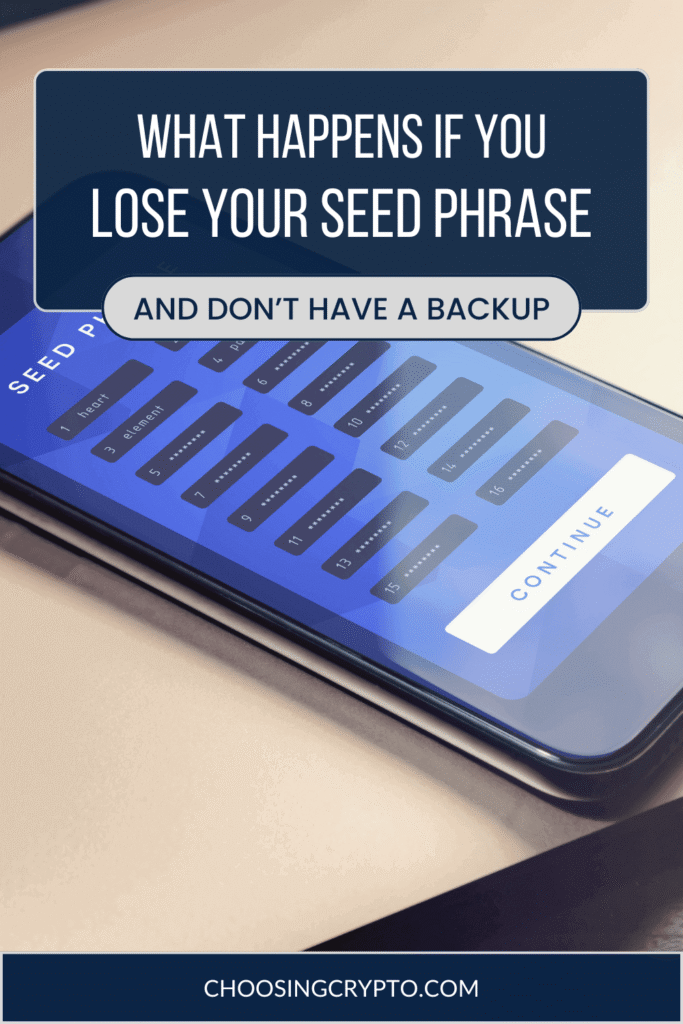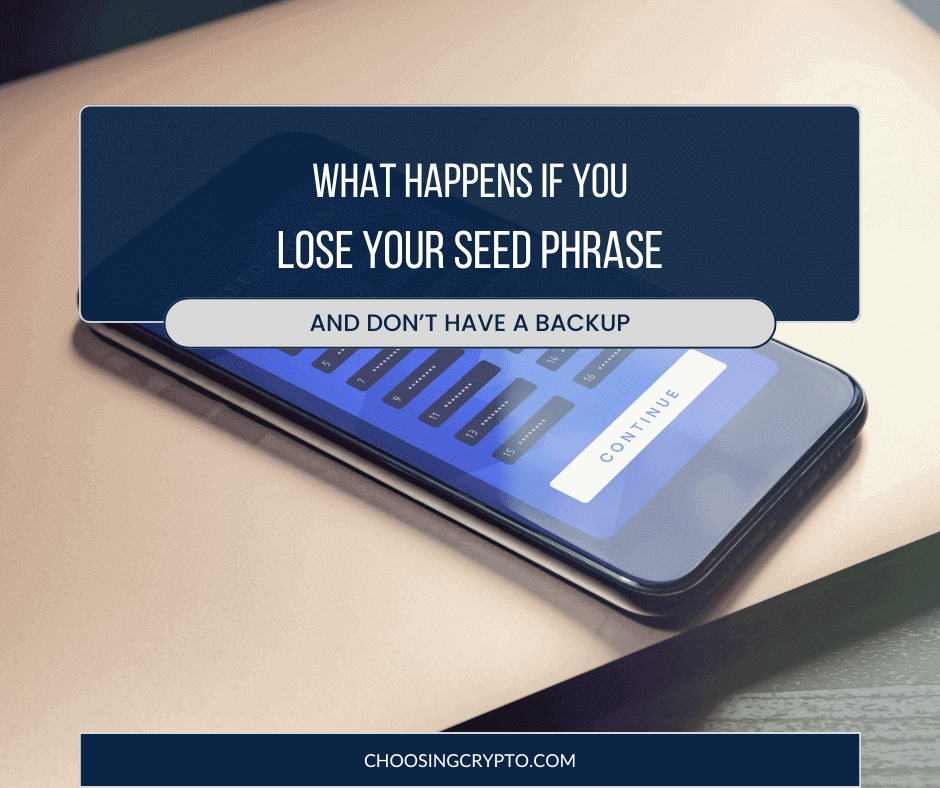Imagine waking up one morning, opening your crypto wallet, and realizing you can’t log in. You also can’t find your seed phrase. Your coins are still there, but out of reach.
Many beginners confuse a seed phrase with a password. It’s not. A bank can help you reset your login, but no one, not even the wallet company, can recover a lost seed phrase. That harsh truth surprises most people.
By the end of this post, you’ll know what happens if you lose your seed phrase, what to do next, and how to make sure it never happens.
New to crypto? I offer beginner-friendly 1-on-1 coaching, and your first session is free. Check it out here.
What a Seed Phrase Actually Does
A seed phrase is a set of 12–24 words that serves as the master key to your crypto wallet, allowing you to recover your coins if your wallet app or device is lost. With it, you, or anyone who has it, can recreate your wallet on another device and instantly access all the crypto inside.
This makes the seed phrase incredibly powerful. It’s both your lifeline and a major risk. Lose access to your wallet, and the seed phrase is your only way back in. But if someone else gets it, they can drain your funds, and there’s no way to reverse it. That’s why truly understanding what a seed phrase does, and protecting it with extreme care, is essential for every crypto user.
What to Do If You’ve Lost Your Seed Phrase
First, don’t panic. Many people recover theirs by retracing simple steps. Here’s where to begin:
1. Check for Old Written Copies
When people first create a wallet, they often jot down the seed phrase on paper, a sticky note, or in a notebook. Over time, it’s easy to forget where it ended up—inside a drawer, tucked in a book, or hidden in a safe spot. Taking a few minutes to search through these places can mean the difference between recovering your money and losing it forever. You’d be surprised where people find them.
2. Look Through Devices and Cloud Backups
Some people save their seed phrase digitally—on a phone note app, in an email draft, screenshots, or even in cloud storage. While unsafe, finding one could be your only shot at recovery. Imagine the relief of opening an old “Notes” app file and discovering that your seed phrase is still intact. Search your devices for keywords such as “seed,” “wallet,” “backup,” or your specific crypto wallet name.
3. See If You’re Still Logged In Somewhere
Even if you’ve lost your seed phrase, check every device where you’ve used your wallet—phones and laptops. There’s a chance you’re still logged into one. If that’s the case, transfer your funds to a new wallet (with a securely stored seed phrase this time) before you lose access.
You May Like: How to Store Your Seed Phrase Securely
Can You Recover a Lost Seed Phrase?
Let’s break down the realities so you know exactly what’s possible and what isn’t.
No Official Way — And Here’s Why
Unlike your email or bank account, there’s no “forgot password” button for crypto wallets. Your seed phrase is mathematically tied to your private keys, which prove ownership of your coins. Once it’s lost, no wallet company can restore it. And that’s because they never had it. Right now, please accept that no support team can assist you. Write it down as a non-negotiable crypto rule: “If I lose it, it’s gone.” This mindset will push you to treat your backup with the seriousness it deserves.
The Myth of Brute-Forcing and Quantum Tech
Some think they can brute-force a seed phrase by trying combinations. But with 12–24 words from 2,048 choices, the possibilities are beyond astronomical. Even supercomputers would take longer than the age of the universe. While quantum tech is advancing, experts agree we’re still decades away from anything close to that capability, and crypto will adapt long before it becomes a threat. Knowing this protects you from scammers who promise “seed phrase recovery services.”
What Really Happens If You Lose Your Seed Phrase Without a Backup
Ever wondered what happens if you lose your seed phrase and don’t have a backup? The reality is far harsher than most people think.
No Official Way to Recover Your Crypto
If you lose your seed phrase, you lose the only key that can restore your wallet. There’s no reset button and no customer support to fall back on. Once it’s gone, access to your coins ends the moment you need to reinstall or restore your crypto wallet.
Many beginners feel safe as long as they’re still logged in. But that’s temporary. If the app is deleted, your phone is damaged, or the device is lost, so are your coins. The only real protection is creating a secure backup before that happens.
Your Crypto Stays on the Blockchain but You Can’t Spend It
When a seed phrase is lost, your coins don’t vanish. No, your coins remain on the blockchain, visible but forever untouchable. They turn into what many call “ghost coins.”
This happens more often than you think. Chainalysis, a top blockchain analytics firm, estimates that around 20% of all Bitcoin is permanently lost. That’s hundreds of billions of dollars, not from hacks or theft, but from misplaced or forgotten seed phrases. You don’t want your crypto added to those statistics. Or, do you?
Wallet Apps or Hardware Can’t Save You and Here’s Why
Wallet apps and hardware devices are just tools. They help you access your coins, but they aren’t the source of ownership. If your phone, laptop, or hardware wallet breaks, you can replace the device and still recover your crypto, as long as you have the seed phrase. What you can’t replace is a missing seed phrase.
Many beginners wrongly believe the app “stores” their funds. It doesn’t. Your coins live on the blockchain, and the seed phrase is the only way to unlock them. Devices are temporary. Your seed phrase is permanent.
Simple Steps to Make Sure You Never Lose Your Seed Phrase
Here are a few simple, practical steps you can take today to make sure you never lose your seed phrase.
1. Back It Up in Multiple Places
Relying on a single copy of your seed phrase is a huge risk. Fire, theft, floods, or even simple misplacement can erase your only backup. Two or three copies stored in separate, secure locations protect you from the unexpected and could mean the difference between a minor inconvenience and losing everything.
Therefore, create at least two physical backups and store them in separate, secure locations, such as a home safe and a safety deposit box.
2. Use Durable Backup Materials
Paper might seem fine at first, but it isn’t built to last. Ink fades, water smears, and fire can destroy it in seconds. That’s why many serious crypto holders rely on steel seed storage kits. Steel is fireproof, waterproof, and built to last a lifetime.
Imagine trying to recover your wallet years from now, only to find your paper copy unreadable. If steel feels extreme for you, at least use permanent ink and keep your paper in a fireproof, waterproof safe.
3. Keep Backups Offline (Never Store Digitally)
Screenshots, cloud storage, or even notes apps might seem easier, but they’re dangerous. Anything online leaves a trail that hackers can exploit. One breach is all it takes to empty your wallet. Offline, physical storage is the only safe option.
If you’ve ever saved your seed phrase on a phone, email, or cloud, replace it with a secure, offline copy and delete the digital one immediately.
4. Test Your Backup Before Relying on It
A backup is worthless if it doesn’t work. Typos, missing words, or unreadable writing are common mistakes. The solution is to test yours now, if you haven’t. Restore your wallet on a spare device and confirm it works before relying on it.
You don’t want to discover an error only after losing access.
Want personal help with crypto? I offer 1-on-1 coaching, and your first session is free. Book your free session here.
Additional Resources:
And guess what? We’re also on Instagram and X (Twitter). Join us there for even more fun and useful content!

DISCLAIMER:
The information provided here is for informational purposes only. Do not rely solely on it for making investment decisions. It is not financial, tax, legal, or accounting advice. Always do your own research or consult a financial advisor before investing in cryptocurrency.
